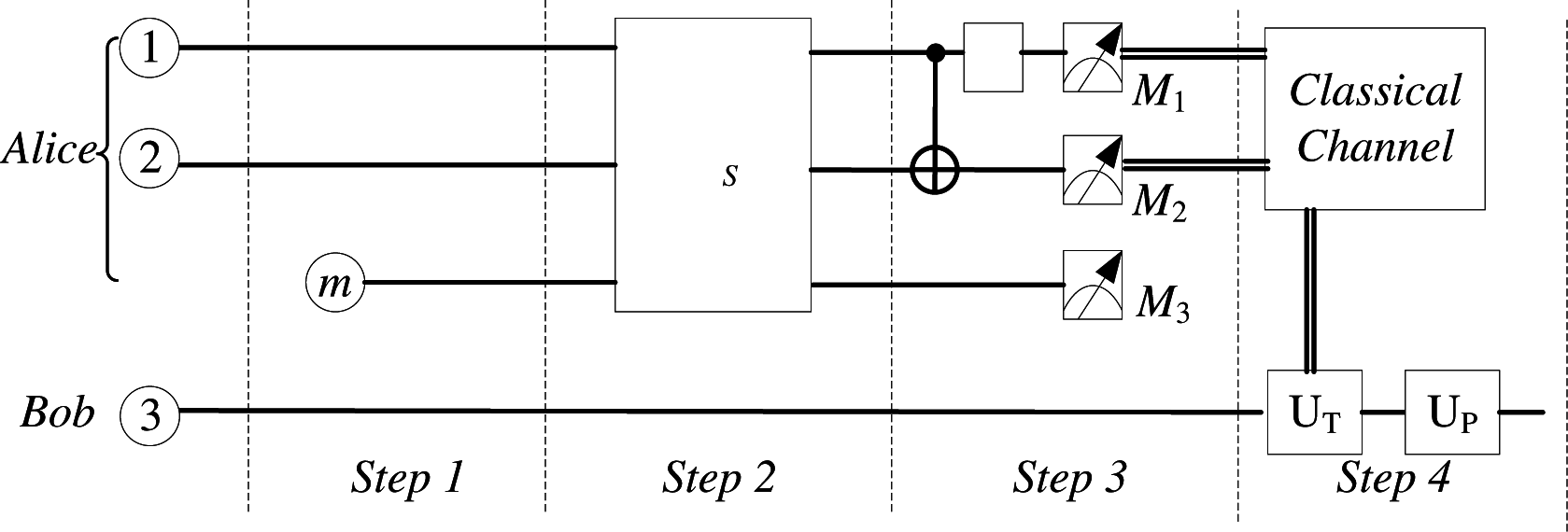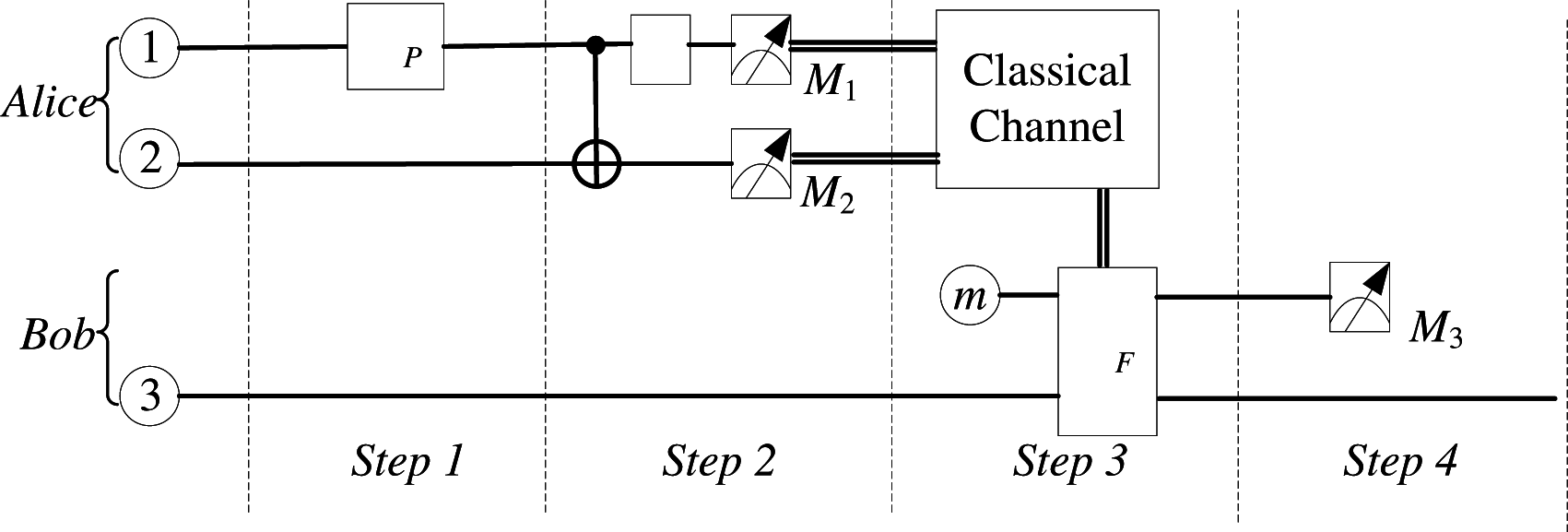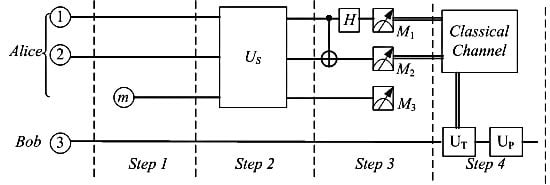Probabilistic Teleportation via Quantum Channel with Partial Information
Abstract
:1. Introduction
2. Different Conditions of Quantum Channel with Partial Information
3. The Teleportation for Partial Information Quantum Channel
3.1. Alice only Knows the Amplitude Factor a, and Bob only Knows the Phase Factor ϕ
- Step 1: A particle m who plays an auxiliary function in teleportation with an initial state |0m〉 is introduced by Alice, and then Alice’s state which is composed of particles 1, 2, m and 3 will take the form of the following Equation (3).
- Step 2: Following on the heels of step 1, an operation named US will be performed on all particles including 1, 2 and m by Alice. If the quantum channel is maximal entangle state, the US could be bypassed. The US operation is an unitary transformation, could be expressed as Equation (4).where 0 is the 2 × 2 zero matrix, σz and A(a) could be expressed asThen the whole system will becomewhere the Bell-state measurements and are given by
- Step 3: Subsequently, the auxiliary particle m is measured and particles 1 and 2 are performed in the form of the Bell-state measurements. Then, Alice transmits measurement results information to Bob in the manner of classical channel.
- Step 4: Bob will perform two continuous unitary operators UP and UT on particle 3 to obtain the original state according to the information including the information received from Alice via classical channel and the local phase factor. Table 1 shows the corresponding relations between the outcomes of measurement and the unitary transformation UT for particle 3. The unitary operation UP, relative to the phase factor ϕ of Equation (2), is described as Equation (9).
3.2. Alice only Knows the Phase Factor ϕ, and Bob only Knows the Amplitude Factor a
- Step 1: Alice performs the unitary operation UP on particle 1 shown as Equation (9) using the phase information owned by herself, as a consequence, the total system can be expressed aswhere and are given by Equations (7) and (8), respectively.
- Step 2: Alice performs the Bell-state measurements on particles 1 and 2. Subsequently, Alice informs Bob of her measurement results using classical channel.
- Step 3: Similar to the condition presented in previous subsection, an auxiliary particle which could be marked as m is introduced necessarily. Then, an unitary transformation UF which can be written as Equation (11) will be performed on particles 3 and m depending on the remote and local information. The unitary transformations in Table 2 are the 2 × 2 matrix. Table 2 shows the corresponding relations between the measurement results on particles 1, 2 and the unitary transformation UF on particles 3 and m, and then the origin state is appeared.where σz and A(a) could be expressed as Equation (5).
- Step 4: Subsequently, To obtain the origin state of qubit, only one measurement result of particle m is in need. There are two cases for the result. In case of that the state of m is |1m〉, quantum teleportation fails. In the other case that the state of m is |0mi, the teleportation will be realized with the same probability of for four different kinds showed in Table 2, and then the sum of success probability is 2 − 2a2. To put it in another way, the success probability is decided by the entangle state as discussed in Section 3.1.
4. Discussion and Conclusions
Acknowledgments
Author Contributions
Conflicts of Interest
References
- Bennett, C.H.; Brassard, G.; Grepeau, C.; Jozsa, R. Teleporting an Unknown Quantum State via Dual Classical and Einstein-Podolsky-Rosen Channels. Phys. Rev. Lett. 1993, 70, 1895. [Google Scholar]
- Nielsen, M.A.; Chuang, I.L. Quantum Computation and Quantum Information; Cambridge University Press: Cambridge, UK, 2000; pp. 17–58. [Google Scholar]
- Bouwmeester, D.; Pan, J.W.; Mattle, K.; Eibl, M.; Weinfurter, H.; Zeilinger, A. Experimental Quantum Teleportation. Nature 1997, 390, 575–579. [Google Scholar]
- Boschi, D.; Branca, S.; Martini, F.D.; Hardy, L.; Popescu, S. Experimental Realization of Teleporting an Unknown Pure Quantum State via Dual Classical and Einstein-Podolsky-Rosen Channels. Phys. Rev. Lett. 1998, 80, 1121. [Google Scholar]
- Lo, H.K. Classical Communication Cost in Distributed Quantum Information Processing: a Generalization of Quantum Communication Complexity. Phys. Rev. A. 2000, 62, 012313. [Google Scholar]
- Li, W.L.; Li, C.F.; Guo, G.C. Probabilistic Teleportation and Entanglement Matching. Phys. Rev. A. 2000, 61, 034301. [Google Scholar]
- Werner, R.F. All Teleportation Dense Coding Schemes. J. Phys. A. 2001, 34, 7081. [Google Scholar]
- Wei, J.H.; Dai, H.Y.; Zhang, M. A New Scheme for Probabilistic Teleportation and its Potential Applications. Commun. Theor. Phys. 2013, 13, 2115–2125. [Google Scholar]
- Wei, J.H.; Dai, H.Y.; Zhang, M. Two Efficient Schemes for Probabilistic Remote State Preparation and the Combination of both Schemes. Quantum Inf. Process. 2014, 60, 651–663. [Google Scholar]
- Tittel, W.; Jozsa, R. Quantum Physics: Teleportation for two. Nature 2015, 518, 491–492. [Google Scholar]
- Solís-Prosser, M.A.; Neves, L. Remote State Preparation of Spatial Qubits. Phys. Rev. A. 2011, 84, 012330. [Google Scholar]
- Sheng, Y.B.; Zhou, L.; Zhao, S.M.; Zheng, B.Y. Efficient Single-photon-assisted Entanglement Concentration for Partially Entangled Photon Pairs. Phys. Rev. A. 2012, 85, 012307. [Google Scholar]
- Sheng, Y.B.; Zhou, L.; Zhao, S.M. Efficient Two-step Entanglement Concentration for Arbitrary W States. Phys. Rev. A. 2012, 85, 042302. [Google Scholar]
- Yeo, Y.; Liu, T.Q.; Lu, Y.E.; Yang, Q.Z. Quantum Teleportation via a Two-qubit Heisenberg XY Chaineffects of Anisotropy and Magnetic Field. Phys. Rev. A. 2005, 38, 3235. [Google Scholar]
- Chiribella, G.; Giovannetti, V.; Maccone, L.; Perinotti, P. Teleportation Transfers only Speakable Quantum Information. Phys. Rev. A. 2012, 86, 010304. [Google Scholar]
- Ekert, A.K. Quantum Cryptography Based on Bell’s Theorem. Phys. Rev. Lett. 1991, 67, 661. [Google Scholar]
- Bennett, C.H.; Brassard, G.; Mermin, N.D. Quantum Cryptography without Bell’s Theorem. Phys. Rev. Lett. 1992, 68, 557. [Google Scholar]
- Li, X.H.; Deng, F.G.; Zhou, H.Y. Efficient Quantum Key Distribution over a Collective Noise Channel. Phys. Rev. A. 2008, 78, 022321. [Google Scholar]
- Bennett, C.H.; Brassard, G.; Popescu, S.; Schumacher, B.; Smolin, J.A.; Wootters, W.K. Purification of Noisy Entanglement and Faithful Teleportation via Noisy Channels. Phys. Rev. Lett. 1996, 76, 722. [Google Scholar]
- Liu, X.S.; Long, G.L.; Tong, D.M.; Feng, L. General Scheme for Superdense Coding between Multiparties. Phys. Rev. A. 2002, 65, 022304. [Google Scholar]
- Grudka, A.; Wojcik, A. Symmetric Scheme for Superdense Coding between Multiparties. Phys. Rev. A. 2002, 66, 014301. [Google Scholar]
- Hillery, M.; Buzek, V.; Berthiaume, A. Quantum Secret Sharing. Phys. Rev. A. 1999, 59, 1829. [Google Scholar]
- Karlsson, A.; Koashi, M.; Imoto, N. Quantum Entanglement for Secret Sharing and Secret Splitting. Phys. Rev. A. 1999, 59, 162. [Google Scholar]
- Xiao, L.; Long, G.L.; Deng, F.G.; Pan, J.W. Efficient Multiparty Quantum-secret-sharing Schemes. Phys. Rev. A. 2004, 69, 052307. [Google Scholar]
- Cleve, R.; Gottesman, D.; Lo, H.K. How to Share a Quantum Secret. Phys. Rev. Lett. 1999, 83, 648. [Google Scholar]
- Lance, A.M.; Symul, T.; Bowen, W.P.; Sanders, B.C.; Lam, P.K. Tripartite Quantum State Sharing. Phys. Rev. Lett. 2004, 92, 177903. [Google Scholar]
- Deng, F.G.; Li, X.H.; Li, C.Y.; Zhou, P.; Zhou, H.Y. Improving the Security of Multiparty Quantum Secret Sharing Against Trojan Horse Attack. Phys. Rev. A. 2005, 72, 044302. [Google Scholar]
- Long, G.L.; Liu, X.S. Theoretically Efficient High-capacity Quantum-key-distribution Scheme. Phys. Rev. A. 2002, 65, 032302. [Google Scholar]
- Deng, F.G.; Long, G.L.; Liu, X.S. Two-step Quantum Direct Communication Protocol Using the Einstein-Podolsky-Rosen Pair Block. Phys. Rev. A. 2003, 68, 042317. [Google Scholar]
- Wang, C.; Deng, F.G.; Li, Y.S.; Liu, X.S.; Long, G.L. Quantum Secure Direct Communication with High-dimension Quantum Superdense Coding. Phys. Rev. A. 2005, 71, 044305. [Google Scholar]
- Sheng, Y.B.; Deng, F.G. Deterministic Entanglement Purification and Complete Nonlocal Bell-state Analysis with Hyperentanglement. Phys. Rev. A. 2010, 81, 032307. [Google Scholar]
- Sheng, Y.B.; Deng, F.G. One-step Deterministic Polarization-entanglement Purification Using Spatial Entanglement. Phys. Rev. A. 2010, 82, 044305. [Google Scholar]
- Ren, B.C.; Du, F.F.; Deng, F.G. Two-step Hyperentanglement Purification with the Quantum-state-joining Method. Phys. Rev. A. 2014, 90, 052309. [Google Scholar]
- Ren, B.C.; Gui, L.L. General Hyperentanglement Concentration for Photon Systems Assisted by Quantum-dot Spins Inside Optical Microcavities. Opt. Express. 2014, 22, 6547–6561. [Google Scholar]
- Chen, Y.N.; Li, C.M.; Chuu, D.S.; Brands, T. Proposal for Teleportation of Charge Qubits via Super-radiance. New J. Phys. 2005, 7, 172. [Google Scholar]
- Liu, J.M.; Guo, G.C. Quantum Teleportation of a Three-particle Entangled State. Chin. Phys. Lett. 2002, 19, 456–459. [Google Scholar]
- Long, L.R.; Li, H.W.; Zhou, P.; Fan, C.; Yin, C.L. Multiparty-controlled Teleportation of an Arbitrary GHZ-class State by Using a D-dimensional (N+2)-particle Nonmaximally Entangled State as the Quantum Channel. Sci. China Phys. Mech. Astron. 2011, 54, 484–490. [Google Scholar]
- Carlo, G.G.; Benenti, G.; Casati, G. Teleportation in a Noisy Environment: A Quantum Trajectories Approach. Phys. Rev. Lett. 2003, 91, 257903. [Google Scholar]
- Oh, S.; Lee, S.; Lee, H.W. Fidelity of Quantum Teleportation through Noisy Channels. Phys. Rev. A. 2002, 66, 022316. [Google Scholar]
- Kumar, D.; Pandey, P.N. Effect of Noise on Quantum Teleportation. Phys. Rev. A. 2003, 68, 012317. [Google Scholar]
- Schumacher, B. Quantum Coding. Phys. Rev. A. 1995, 51, 2738. [Google Scholar]
- Gilchrist, A.; Deuar, P.; Reid, M.D. Contradiction of Quantum Mechanics with Local Hidden Variables for Quadrature Phase Amplitude Measurements. Phys. Rev. Lett. 1998, 80, 3169. [Google Scholar]
- Katz, N.; Neeley, M.; Ansmann, M.; Bialczak, R.C.; Hofheinz, M.; Lucero, E.; Connell, A.O.; Wang, H.; Cleland, A.N.; Martinis, J.M.; Korotkov, A.N. Reversal of the Weak Measurement of a Quantum State in a Superconducting Phase Qubit. Phys. Rev. Lett. 2008, 101, 200401. [Google Scholar]
- Ellinas, D. Phase Opertors via Group Contraction. J. Math. Phys. 1991, 32, 135–141. [Google Scholar]
- Schuster, R.; Bucks, E.; Heiblum, M.; Mahalu, D.; Umansky, V.; Shtrikman, H. Phase Measurement in a Quantum Dot via a Double-slit Interference Experiment. Nature 1997, 385, 417–420. [Google Scholar]
- Wagner, R.; Clemens, J.P. Performance of a Quantum Teleportation Protocol Based on Temporally Resolved Photodetection of Collective Spontaneous Emission. Phys. Rev. A. 2009, 79, 042322. [Google Scholar]


| Measurement results | State of Particles 3 | Probabilities | UT | |
|---|---|---|---|---|
| Particle m | Particles 1, 2 | |||
| |0m〉 | α∣03〉 + ∣βeiϕ∣13〉 | I | ||
| α∣03〉 − βeiϕ∣13〉 | σz | |||
| α∣13〉 + βeiϕ∣03〉 | σx | |||
| α∣13〉 − βeiϕ∣03〉 | iσy | |||
| |1m〉 | – | – | 2a2−1 | – |
| BMRs on particles 1, 2 | UF | Results after the transformation UF | ||
|---|---|---|---|---|
| Particle m | Particle 3 | Probabilities | ||
| ∣0m〉 | α∣03〉 + β∣13〉 | |||
| ∣1m〉 | ∣03〉 | |||
| ∣0m〉 | α∣03〉 + β∣13〉 | |||
| ∣1m〉 | ∣13〉 | |||
| ∣0m〉 | α∣03〉 + β∣13〉 | |||
| ∣1m〉 | ∣13〉 | |||
| α∣03〉 + β∣13〉 | ||||
| ∣13〉 | ||||
© 2015 by the authors; licensee MDPI, Basel, Switzerland This article is an open access article distributed under the terms and conditions of the Creative Commons Attribution license (http://creativecommons.org/licenses/by/4.0/).
Share and Cite
Liu, D.; Huang, Z.; Guo, X. Probabilistic Teleportation via Quantum Channel with Partial Information. Entropy 2015, 17, 3621-3630. https://doi.org/10.3390/e17063621
Liu D, Huang Z, Guo X. Probabilistic Teleportation via Quantum Channel with Partial Information. Entropy. 2015; 17(6):3621-3630. https://doi.org/10.3390/e17063621
Chicago/Turabian StyleLiu, Desheng, Zhiping Huang, and Xiaojun Guo. 2015. "Probabilistic Teleportation via Quantum Channel with Partial Information" Entropy 17, no. 6: 3621-3630. https://doi.org/10.3390/e17063621
APA StyleLiu, D., Huang, Z., & Guo, X. (2015). Probabilistic Teleportation via Quantum Channel with Partial Information. Entropy, 17(6), 3621-3630. https://doi.org/10.3390/e17063621






